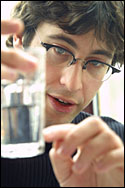Evolution revolution
As the latest recipient of the Natural Sciences and Engineering Research Council of Canada's prestigious Doctoral Prize, as well as NSERC's Howard Alper Postdoctoral Prize, Rees Kassen would like to thank all the little microbes who helped him out along the way.
 Dr. Rees Kassen
Dr. Rees KassenPHOTO: Owen Egan |
|
Since defending his PhD dissertation at McGill last year, Kassen has been dividing his time between Canada and Oxford, where he's working in the Department of Plant Sciences. (Of his jetsetting lifestyle, Kassen quips, "I'm going for that Cary Grant, mid-Atlantic accent.") It was during a recent return to Canadian soil that Kassen learned of his NSERC nod.
Kassen's dissertation, as well as his current Oxford research, involves Pseudomonas fluorescens -- in lay terms, "pond scum"-- to understand the causes of biodiversity. Specifically, he uses the microbes to follow ecological and evolutionary processes in real time.
"Using micro-organisms means you can do the sorts of experiments you wouldn't be able to do with big, furry organisms," he explains while sitting in a Mile End café during his Montreal pit stop. "They are small, they have very simple genetics, and you get large populations -- which means you don't have to worry about the frustrating influence of only sampling something just by chance because you only have a few individuals. You can do proper experiments that are replicated, and you don't have to wait years for a single generation."
It's a relatively young field, but not, however, a new idea. Kassen says the approach can be traced back to the late 1800s, when a Wesleyan clergyman and micro-scopist named Rev. Dr. W.H. Dallinger built a "very Victorian, elaborate cast-iron incubator" filled with micro-organisms, and gradually increased the temperature every week for seven years. The experiment literally ended with a bang, but not before the good Reverend managed to perform a "reciprocal transplant experiment" -- that is, he tried to grow the specialized micro-organisms at regular temperatures (they died), and to grow non-specialized micro-organisms at the higher temperatures (they died, too). Sensing that his findings might be used to test theories of natural selection, an excited Dallinger wrote to Charles Darwin.
"Darwin was a bit too much of a natural historian to cotton onto it," says Kassen. "He was like, 'Oh, that's very interesting. It might explain the growth of bacteria around hydrothermal vents!' But he didn't clue into the possibilities, and nobody else really bothered with it until the early 1990s -- everybody was busy doing fruit flies!"
Kassen's research started in Dr. Graham Bell's lab, one of the few devoted to using micro-organisms to study evolution. He looks at how natural selection affects "bugs" (bacteria, algae -- again, your basic "pond scum") growing in either a heterogeneous or homogeneous environment.
"Say this is your microcosm," he says, picking up a glass of water. "If you put a bacteria in and just leave it in an incubator and come back in five days, the broth will be opaque with bacteria. And there's also a thin surface mat -- if you dropped a pellet into the test tube, you'd see the mat covering the pellet as it fell -- so you can see some sort of diversity of bacteria within that microcosm.
"That's what happens if you just leave the microcosm for five days: you get incredible diversity in a uniform environment. But if you put the same original bacteria in the microcosm, and then shake the microcosm like this" -- Kassen shakes his water glass, much to the amusement of a passing waitress -- "you don't allow the mat to form because any bug that tries is just going to get shaken off.
"So you destroy the spatial structure of the microcosm. When that happens, and you go back and take out a sample, you see that there's only one type of bacteria. So a still microcosm is a spatially structured world, but a shaken one isn't -- and it doesn't support the diversity."
Kassen's work has applications that reach much further than just clowning around in restaurants. Perhaps the most obvious, since he's dealing with biological diversity (albeit at a micro-level), involves changing the ways conservation biologists approach their work. Because Kassen's work proves that heterogeneity breeds diversity, he says, "We should choose regions to conserve that are much more heterogenous, regions that have a lot of different kinds of habitats -- don't just save the St. Lawrence valley, save the valley and the hills around it."
Kassen says there are also medical applications on the horizon, specifically in terms of countering the growing problem of multi-drug resistance. "Using multiple drugs, for example in HIV treatments, is, from the perspective of a virus or disease-causing agent, a heterogeneous environment. So the question is: what's the best strategy for delivering drugs to a patient and preventing the evolution of a single, broadly adapted virus?"
Simply put, now is a very good time to be into pond scum.
"It's still a relatively new field," he says, "which is one of the reasons why it's so exciting. Even today, ecologists can be a bit reserved about these experiments -- 'Fine, this might work in a test tube, but that doesn't mean anything about what's going on in nature' -- and in some senses they're right. But one of the great things about the work that I'm doing, and the work being done at the lab at McGill, is that it can show you what is a plausible mechanism to explain something in nature."
Kassen pauses to sip from his microcosm, then adds, "Plus, you can literally watch evolution happening right before your eyes!"

